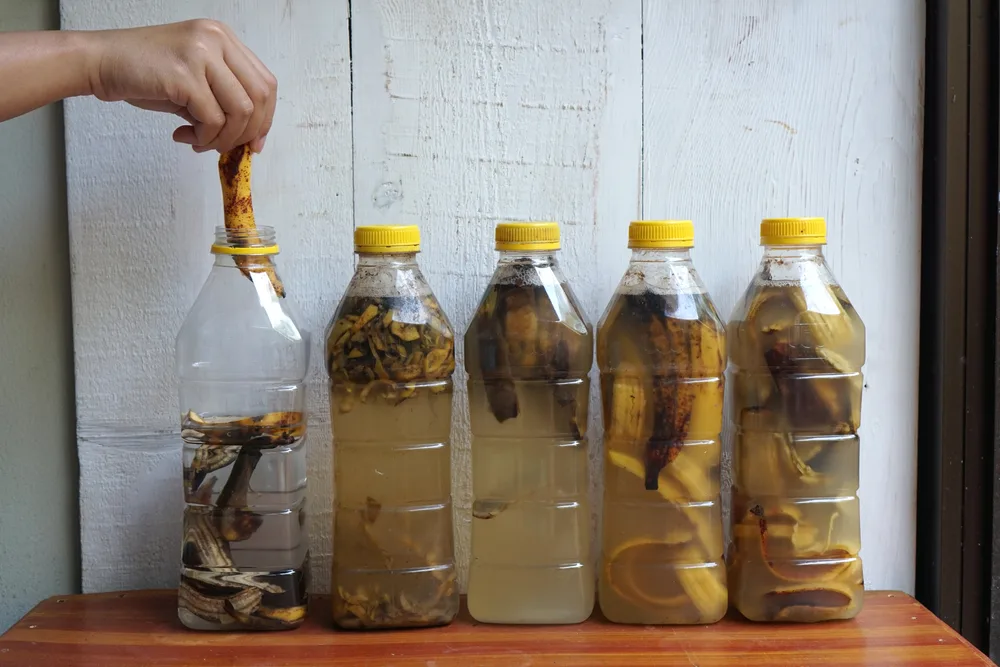According to trendspotters, plants are the new pets. It’s no wonder plant parents are always seeking the latest tips to help their indoor and outdoor plants thrive.
Plant enthusiasts have been excited about using coffee grounds and eggshells for their plants in the past. Recently, home gardeners have discovered a promising new DIY product: homemade banana water.

Stephanie Stephenson, author of Rose Gardening, explains that this trend has taken off because “making banana peel water is simple and easy… plus it acts as a natural fertilizer for [outdoor and indoor plants].”
Bananas are packed with potassium, calcium, phosphorus, and magnesium, which can significantly benefit your plants’ growth.
If you’re curious, keep reading to learn how to make your own batch to help your plants flourish. This trick will make you eager to use produce to boost your garden, and you might also get interested in learning about composting.
What is Banana Water?
Banana water is simply water infused with banana peels. To make it, soak banana peels in water for a few weeks in a jar or bucket, then pour the liquid onto your plants. (We’ll go through the detailed steps soon.)
Soaking banana peels releases nutrients like potassium and calcium into the water, creating an affordable, homemade liquid fertilizer.
Does Banana Water Work?
Some gardeners swear by it, though there’s no scientific proof yet that banana water contains enough potassium to significantly benefit plants.
However, the theory behind using banana water is solid: bananas are high in potassium, an essential nutrient that promotes plant growth, strengthens stems, and helps plants resist drought and pests.
Banana peels must break down to release nutrients that plants can absorb, similar to compost. A study from Makerere University College suggests that boiling banana peels may release more potassium, but further research is needed.
Many home gardeners claim they’ve seen improvements in their plants after using banana water. Aster W. Green, author of Companion Planting in Raised Bed Gardens, notes that banana water is an “organic way to enhance your watering routine [and] avoid costly synthetic fertilizers.”
What Plants Like Banana Water?
Banana water can be used in any garden or houseplant. While more research is needed to confirm its effectiveness, it won’t harm your plants.
Extra potassium is particularly beneficial for fruiting and flowering plants, though all plants can use a potassium boost.
If you’re unsure which plants to try banana water on, Stephenson suggests considering “tomatoes, peppers, roses, orchids, succulents, staghorn ferns, air plants, and banana trees.”
She adds that banana peel water can help prevent blossom end rot in tomatoes, which causes the bottom of the tomato to turn brown.
“Magnesium aids in photosynthesis and helps plants flower or fruit more effectively.”
Is Banana Water Safe for All Plants?
Generally, yes. Banana water is safe and won’t stunt plant growth. However, conventionally grown bananas are often treated with synthetic pesticides, so you might avoid using banana water on food crops if you maintain an organic garden. To bypass this, use peels from organic bananas.
While banana water contains important nutrients, it doesn’t provide everything your plants need. Relying solely on banana water may lead to nutritional deficiencies.
Use it alongside other organic products, like compost or fertilizer. Rice water can also be a great addition to your garden care routine.
How Do I Make Banana Water for Plants?
Making banana water is easy. You’ll need banana peels, water, and a large jar or bucket. Besides benefiting your plants, repurposing banana peels reduces food waste and adds greenery to your home. Follow these steps to make your batch.
Step 1: Save Your Banana Peels
After eating a banana, save the peel. “Place your banana peels in a container and cover them two-thirds with water,” says Green. Continue adding peels until the container is full. Cover the jar to prevent odors and mold.
Cut the peels into one-inch squares or blend them before adding them to the jar to speed up the breakdown.
Step 2: Brew the Banana Water
Once your jar is full, place it in a cool, dark area and steep the peels for two to three weeks. When ready, the peels will turn black, and the water will darken. A slight odor is normal during brewing, but the banana water will be odorless.
For faster results, steep the peels for a few days, then boil the mixture for 30 to 45 minutes. Let it cool before using. This method may release more nutrients quickly.
Step 3: Remove the Peels
After steeping, strain out the solids and pour the liquid into a watering can. To avoid waste, compost the leftover banana peels.
Step 4: Water Your Plants
Use banana water as part of your regular watering routine for houseplants, container gardens, and in-ground beds.
Room-temperature banana water can be used immediately. However, boiled banana water should be diluted (one part to five parts) before use and ensure it has cooled down.
How Often Should I Use Banana Water on My Plants?
Apply banana water weekly as part of your normal watering schedule. Fill your watering can with banana water and water your plants at the soil line to avoid damp leaves and mildew. Water succulents and cacti more sparingly to prevent root rot.
Is There an Alternative Fertilizer for My Plants?
Banana water alone doesn’t provide all the nutrients plants need. For a balanced nutrient supply, consider using organic fertilizer, like hydrolyzed fish and seaweed fertilizer by Neptune’s Harvest or Down to Earth kelp meal fertilizer.
If you compost, consider composting banana peels instead.
Microbes break down banana peels and other organic matter during composting, making nutrients more accessible to plants. Use composted banana peels as a top dressing or brew them into compost tea for your plants.
